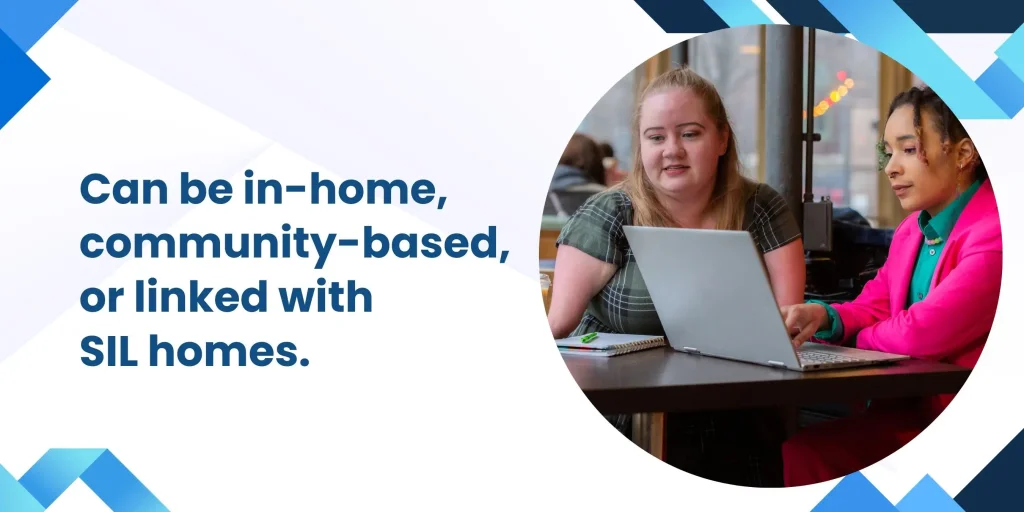Starting the process of supported independent living can be overwhelming. For most families and individuals, it’s a mix of hope, fear, and an infinite list of questions. What does it really look like? How do you find the right supports? Can you be more independent but still feel safe, connected, and confident?
The truth is, well-supported independent living isn’t just a case of securing a new home to live in. It’s a case of constructing a life to suit someone’s goals, needs, and habits. And where the transition is well-supported, it can give rise to more freedom, more secure routines, and fuller day-to-day life.
This article walks you through what supported independent living actually is, who it is for, and how to go about it step by step. Whether you are exploring options for yourself or a loved one, the hope is that the process will become easier to grasp, more empowering, and less intimidating.
What Is Supported Independent Living?
Supported independent living (SIL) is one of the types of NDIS-funded support where a person with disability can live at home or shared accommodation with individualised daily assistance. It could include help with activities such as:
- Personal routines of care (e.g., showering, dressing, or grooming)
- Meals planning and preparation
- Reminder and management of medication
- Skill development of living such as budgeting, shopping, or transport
- Social engagement and access to the community
SIL does not pay for groceries or rent. Instead, it pays for the help individuals need to live independently and receive care that is tailored to their personal needs and objectives.
Who Is SIL Appropriate For?
Supported independent living is appropriate for individuals who need constant help at home but would prefer to make efforts toward independent living. Such individuals include those:
- With intellectual, physical, or psychosocial disability
- Who want to live more independently than current living arrangements allow
- Who need daily living assistance on a regular basis
- Who would benefit from a formal support environment
Some live alone with SIL support, others live with housemates and have support workers come and stay overnight. The model is flexible and can be built around what best suits the person.

Step-by-Step: How to Transition Into Supported Independent Living
Transitioning into SIL doesn’t happen overnight. But with the right plan in place, it becomes a smooth process with fewer surprises. Here’s a simple breakdown of what to expect.
Step 1: Understanding Your Needs and Goals
Everyone is an individual. In the first instance, think what independence means for that person. Is it personal care in one’s own power without needing prompts? Being able to cook one’s own meal without worry? Or simply having more confidence in coping with the daily routine?
A few things to have in mind:
- What part of daily living can currently be done?
- Where will extra support be needed most?
- Are there longer-term goals in mind, i.e., the ability to cook or manage a budget?
- Is the current living situation facilitating or detracting from independence?
Recording these thoughts can be a useful method of preparing for your NDIS planning meeting.
Step 2: Getting a Functional Assessment
A functional assessment in most cases will have to be provided as part of the application for SIL funding. This is a thorough examination by an allied health professional, such as an occupational therapist. The assessment will consider:
- How daily life is currently organised
- The type of support that is required
- The amount of support required daily
- Whether SIL is the optimal type of support
The report assists the NDIS in determining what extent of support is required and guarantees that any plan is constructed around actual, achievable needs.
Step 3: Talking About SIL at Your NDIS Planning Meeting
If you are having your first plan or plan review, talk to your NDIS planner or Local Area Coordinator about your need for supported independent living. Bring any assessment reports and personal goals with you.
It’s also the time to ask if you require seeking Specialist Disability Accommodation (SDA), in case your requirement is greater, and you require specially built homes. Not everyone receiving SIL qualifies for SDA, nor do all with SDA receive SIL. Your NDIS team can help guide the options.
Step 4: Working with an Appropriate SIL Provider
Once SIL is accepted in your NDIS plan, the next step is to find a provider who offers the right kind of support in the right environment. This is not just a question of availability. It is finding a team and an environment where the person feels heard, respected, and safe.
Questions to ask when talking with providers:
- What kind of support is provided and how often?
- Can the supports be individualised to personal routines?
- What kind of training do the staff get?
- How does the provider interact with families or guardians?
- Can you greet the team and visit the property in advance?
It’s okay to interview a couple providers before making a decision. This is a huge decision and having the right fit is everything.
Step 5: Planning the Move
After you’ve chosen the right provider and home, it’s time to make arrangements for the transition. A good provider will help you:
- Gradually introduce the new environment
- Create routines and goals
- Identify any equipment needed for the home
- Transferring medications and medical history
- Scheduling visits, trial stays, or short accommodation to ease transition
This process often involves confrontational communication among the support coordinators, therapists, families, and the individual himself. The vision is a problem-free and facilitated transition, not a stressed or accelerated one.
Step 6: Modifying and Examining Support Along the Way
Following the transition to supported independent living, even support plans can alter. People become more confident, gain further skills, and sometimes need more or less support according to changing health or lifestyles.
Providers and support workers must offer regular check-ins and be open to feedback. Understand that SIL is not a “set and forget” strategy. Instead, it’s designed to adapt as the person grows and shift as needs evolve.
When SIL Works Well, It Changes Lives
Supported independent living is more than just a place to live. It boosts confidence. It coordinates daily life. It provides people with the ability to try new things, become independent, and create a place in their community.
Families note that they notice a difference. Individuals who once had to rely heavily on others now have their own place, contribute to shared living in their own way, or learn new skills they never imagined they would.
And though the initial steps may seem overwhelming, appropriate support makes the journey not only possible but highly fulfilling.
Conclusion
Supported independent living is a significant choice, but it does not need to be intimidating. As long as the process is divided into simple steps and accompanied by trusted experts, it becomes a journey of hope and possibility.
Trinity Scope and Supports offers experienced allied health professionals who can help with functional assessments, therapy, and support coordination. They know the personal nature of this journey and will be with each individual and family in compassion, clarity, and care.
If you’re just starting to explore your options or are ready to take the next step, call Trinity Scope and Supports for guidance that’s focused on your goals, your needs, and your future.


